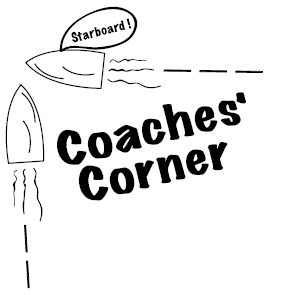by CLEMMIE EVERETT
No matter what happens over the course of a race, your ultimate finishing position depends on how you sail the last leg of the race. People often talk about starting strategy and first beat strategy, but it’s also useful to think about considerations for the last leg, which is often a beat to weather.

Planning for every leg of the course begins on the leg before, and the last beat is no exception. Think back to the first beat, but don’t blindly assume that the same strategy is going to hold true. Reconsider where the best breeze will be on the course, where you’re likely to find favorable windshifts, what effect current will play on the course, and anything else you think is strategically important. Also note the location of the finish line and length of the leg.
The last beat actually begins as you round the leeward mark. Do everything you can to round on the inside, even if it means slowing your boat down and letting boats inside of you round ahead. Rounding just behind leaves you with a better chance for clear air and more tactical options than rounding outside. The only time to round outside is when you are confident that you can get bow out on an inside boat. While rounding, sail wide then tight, using just enough rudder movement and slowly trimming your jib while quickly trimming your main in order to turn the boat while maintaining speed. If there’s a boat just in front of you, pinch just after the mark to try to create the best upwind lane possible. If you have a gap between you and boats behind, you might consider quickly tacking around the mark and then tacking again as your opponents approach the mark, putting yourself directly upwind of the boats behind, and ready to cover.
Now that you have rounded the mark, your job is to stay ahead of the boats behind and pass a few of those ahead. But don’t lose track of your strategy for the entire leg! There may be situations when you need to stay ahead of a particular boat, but too often sailors worry about the boat immediately ahead or behind, and end up winning the battle but losing the war – other boats pass both of you.
If you absolutely must beat a boat behind, you can employ a tight cover. This entails staying directly in between the wind and the boat behind, so you are blocking the wind and giving them disturbed air. If they tack, you tack. However, a tight cover is more dangerous than might appear at first glance. Because your priority is that one boat, you may be taken to an unfavorable side of the course or you may be forced to tack while downspeed. If they have better tacks than you do, beware of being suckered into a tacking duel!
If you keep your head in the game, you will pass boats and stay ahead of the boats behind.
Given the challenges of a tight cover, you will usually want to use a loose cover on the boats behind, and when possible, the entire fleet behind. This means staying in between the other boat and the finish, though not necessarily right on top of other boats. Draw an imaginary line straight back from your stern and a line perpendicular to that from about where your mast is. Now your goal is simply to keep other boats inside of these lines. In this way, you don’t let them get to a situation where a windshift will put them ahead of you. At the same time, you allow yourself the flexibility to sail toward the favored side of the course, to tack when you are at full speed, and, most importantly, to sail toward puffs – definitely do not let boats behind get to a puff that you cannot reach!
If one side of the course is clearly favored, you can use a combination of tight and loose covers to herd boats behind toward this side of the course. When a boat behind is going the direction you do not want to go, use your tight cover to sit directly upwind of them and give them dirty air. In this situation, your opponent should tack away. Instead of tacking immediately with them, wait a moment and tack when they have clear air, but are still within your loose cover. They should then continue that direction, allowing you to execute your strategy while still staying ahead. If your side of the course works out, you may well pass some boats that were ahead!
Finally, keep sailing fast. Don’t let a competitor or something that happened earlier in the race affect your mindset and distract you from doing what you do best. If you keep your head in the game, you will pass boats and stay ahead of the boats behind. Good luck!
Clemmie Everett is the Sailing Director at Noroton Yacht Club in Darien, CT and the Assistant Sailing Coach at Rye Country Day School in Rye, NY. She and crew Susan Doyle won the 2011 Queens Cup at American Yacht Club In Rye, NY.




